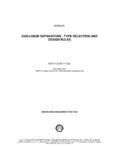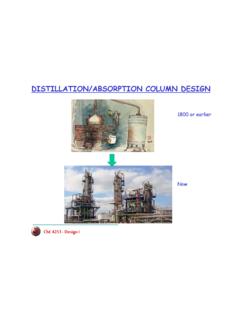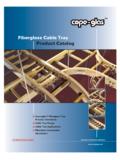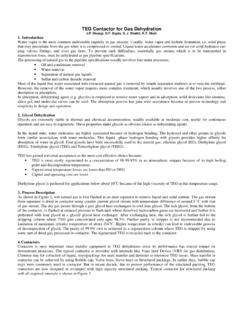Transcription of Valve Tray Pressure Drop - razifar.com
1 Valve tray Pressure drop John T. Thorngren Wyatt Division, , Inc., Dallas, TX 75222 A unified approach to Valve tray Pressure drop is presented. Experimental results of a simulator are shown. Results of applying the method to other published experimental data are also presented. The wet tray Pressure drop model appears potentially applicable to other types of trays. Recently Nyyatt Division of Industries, Inc., intro- duced a new Valve tray as shown in Figure 1. Since there are several other types of proprietary Valve trays on the market, it was decided to unify all types of Valve trays into a general solution for total tray Pressure drop . An additive model of wet and dry tray Pressure drops is used. The dry tray Pressure drop is based on a force balance to determine the equilibrium Valve position above the tray deck.
2 Wet tray drop is corre- lated as a function of weir height, weir crest, and a bubbling area baaed Souders-Brown term. Dry- tray Pressure drop Using air as the flow medium, dry tray Pressure drops were measured on individual test valves mounted in a 4-in. diam column. Points were obtained for four fixed and equally spaced, micrometered positions of the Valve lip from the tray deck. The physical dimensions of the Valve varied during the tests are shown in Table I. A model was developed using conventional contraction and expansion coefficients as based on a presumed flow pat- tern. The flow rate split between that at the Valve lip and that through the Valve body hole was based on a trial-and- error solution assuming an equal driving potential (calculated Pressure drop ).
3 The entrance loss was correlated with tray thickness in a manner similar to that given in Smith (1963) for sieve holes. The turnaround loss also appeared to be a function of tray thickness. An error ratio can be defined as calculated value actual value Error ratio = For the 272 data points taken, the average error ratio was with a std dev of and a max. abs dev of Force Balance Under tower operating conditions, a Valve (partially open) should theoretically rise to a position whereby the vapor uplifting force equals the effective weight of the Valve . The vertical uplift force is composed primarily of the Pressure difference across the Valve and the momentum change due to vapor impact on the Valve . The vapor impact contribution is determined in a manner given in Perry (1963).
4 The Pressure difference is computed via the model described previously. The Pressure difference force, however, is dependent on the Valve position above the tray . Consequently, a trial-and-error solution must be made until the total uplift force equals the effective Valve weight. The effective weight of the Valve covered with aerated liquid might be slightly less than the actual weight due to E/ Figure 1. Wyatt Valve tray buoyancy. Since the buoyancy effect cannot be accurately predicted, the actual weight is used. Any error contribution from this source is expected to be small. Wet- tray Pressure drop Pressure drop data were gathered from an experimental 24-in. diam simulator using air and water base systems. The range of variables studied are shown in Table 11.
5 Using the force balance described previously, the dry tray Pressure drop was determined and the residual wet tray drop was correlated by using a liquid holdup fraction y with the simplifying assumptions: 1. The two-phase dispersion on the tray is uniform. 2. The vapor density is negligible with respect to the liquid 3. Bubble formation losses can be implicitly included as a 4. Liquid entrainment and weeping are not occurring. AP, = y(HW + HOW) density. function of y. Wet tray Pressure drop becomes (2) where the two-phase crest height over the weir HOW was calculated by the Francis formula assuming homogeneous two-phase flow Q [ ydz (LWI - HOW) HOW = zia HOW (4) The fraction y was correlated in terms of y = a + ( - a)/exp VB ~PV/[(PL - pv)DBgl} (5) where a = + ( HW/DB) (6) The bubble diameter DB was not measured and also is not particularly amenable to correlation for the typically turbu- 428 Ind.]]
6 Eng. Chem. Process Des. Develop., Vol. 11, No. 3, 1972 lent conditions associated with fractionation trays. It is suspected of being somewhat constant under these conditions, and hence a fixed value of ft was used in this study. The range on the calculated variable y is also shown in Table 11. Total tray Pressure drop The method was applied to the experimental data set from which the wet tray correlation was derived. For the 440-point data set, the calculated total tray drop had an average error ratio of with a std dev of The max. abs dev waj Fractionation Research, Inc., has tested several proprietary Valve trays in a 4-ft diam column using cyclohexane-heptane and butane. F. W. Glitsch and Sons, Inc. (1970) has released this data on their V-1 type Valve tray , and the method was applied to their Pressure drop runs.
7 For the 12 data points, the calculated total Pressure drop had an average error ratio of with a std dev of and a max. abs dev of Ten of the points were within the average plus and minus the standard deviation. It should be noted that V-1 Valve was not used in developing the dry tray model described previously. Billet (1970) tested several Valve trays in an 800-mm diam column using a styrene- ethylbenzene system. The method was applied to the graphi- cally reported results of a Koch type T Valve (Koch Engineer- ing Co., 1968). The maximum and minimum error ratio nere and , respectively. This Valve mas not used in developing the dry tray model. Mayfield et al. (1952) reported experimental Pressure drop results for sieve trays covering a wide range of tray dimen- sions in an air-water system.
8 The dry tray drop was reported separately. The total tray drop was determined via Equations 2-6 plus the experimental dry tray drop . For those runs in which the weir height was nonzero, the average error ratio was with a std dev of and a max. abs dev of In terms of average absolute error, this becomes with a std dev of As given in Chase (1967), the Prince method shows an average absolute error of for the entire Mayfield data set combined with another author s results. The method recommended in Smith (1963) is reported to have an accuracy of + for the data sets of several investigators including the Slayfield data. Application of Equations 2-6 to sieve trays appears to give about the same accuracy as other methods.
9 Compared to the Valve tray data, calculated results tend to be low and show a wider scatter. It should be noted, however, that the equations were derived from Wyatt Valve tray data and must contain corrections for errors in the dry tray model and force balance. It is also suggested that Valve trays might have a different form of liquid aeration because vapor enters the liquid at a 90 angle for Valve trays and in a straight line for ~ ~~~~ Table 1. Dry tray Pressure drop Valve Dimensions tray hole id., in. Valve body angle, degrees Nominal deck thickness Nominal body hole id., in. Xominal Valve , in. 2, 17v8 1 5475, , 0 0, 21 3, 30 0 10, 12, 14, and 16 gauge, 0 0, I/q, in. plate, 9/64-in. extrusion Table II. Wet tray Pressure drop tray Variables Nominal weir height, in.
10 1 5, 1 75, 2 0, 2 5, 3 0, 3 5,4 5 Gpm/LWI (gpm/in.) 0 0-6 3 Wyatt valves /ft2 bubbling area Vapor density, lb/ft3 vBv PV/(PL - pv) Ycalcd 1 0 to 0 239 4 3. 8 6, 11 8, 20 9 0 073-0 52 Nil to ft/sec Liquid density, lb/ft3 62 1-65 2 sieve trays. An adjustment to the constants in Equations 5 and 6 might prove useful in correlating data for sieve and also other types of trays. The equations are dimensionally sound and offer logical extrapolation. Nomenclature DB = G= g= HOW = HW = LWI = &= IrB = bubble diam, ft acceleration due to gravity, acceleration due to gravity, ft/sec2 TTeir crest height, in. weir height, in. weir height, in. clear liquid flow rate, i~/sec vapor velocity based on bubbling area? ftlsec GREEK LETTERS a, y = wet tray Pressure drop variables APw = wet tray Pressure drop , inches of tray fluid pL = liquid density, lb/ft3 pv = vapor density, lb/ft 3 literature Cited Billet, R.






